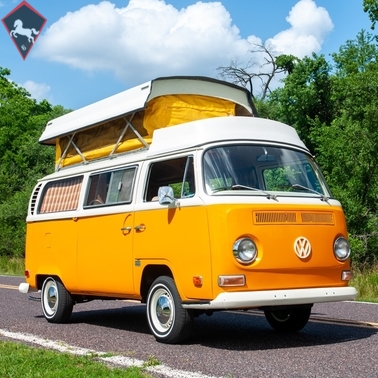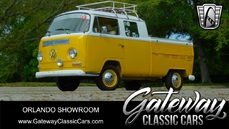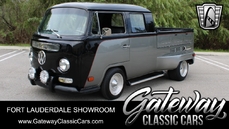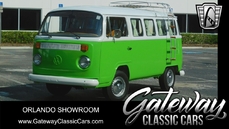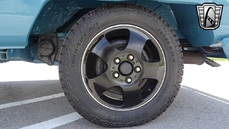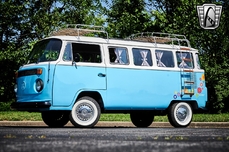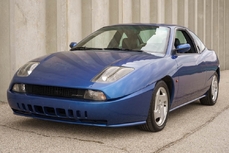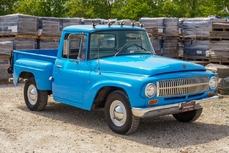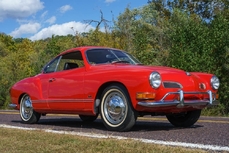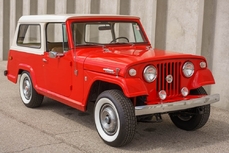Volkswagen Typ 2 Bay window 1.9L four-cylinder 1971
General description :
1971 Volkswagen Westfalia Camper
Fresh restoration inside and out!
Originally from Oregon and California and it really shows
New white over Sierra Yellow (code L11H) exterior with tan and black interior
Rebuilt 1.6L four-cylinder engine bored out to 1.9L
Fewer than 1,000 miles on rebuilt engine
Four-speed manual transmission
New – canvas top, window and body seals, interior, refrigerator
Penthouse upper sleeping cot, front child cot and sofa bed
MotoeXotica Classic Cars has the perfect vehicle for those summer camping trips, a 1971 Volkswagen Westfalia Camper. Often called Westies, these vans with built-in campers still retain a huge following and have been one of the hottest classic cars of 2018! This one is a harder to find early type 2 bus that has the penthouse pop top! Plus it is finished in our personal favorite Sierra Yellow exterior which makes this one hot bus!
This particular example is originally from the Pacific Coast, Oregon and California, specifically, it benefitted from a fresh restoration. Dressed in new White over Sierra Yellow, (code L11H), with new clearcoat on top, the van’s paint and trim are in overall excellent order.
The glass panels on this late bay are in overall great condition, intact with no major cracks, chips or haze. The van’s lights are in excellent order while the van’s bodywork is solid and straight. The white bumpers fit tightly to the body, the engine bay is very tidy and the cargo bay is in great shape. This Westie has a new canvas top plus new window and body seals.
The van rolls on a fresh set of Hankook Optimo whitewall tires, size 185/75R14 at all four corners. The tires have lots of tread while the factory, vented steel wheel covers are in overall very good order.
Out back, there is a rebuilt 1.6L four-cylinder engine that has been bored out to 1.9L and has fewer than 1,000 miles on it since the rebuild. This motor really pulls strong and the extra power and torque is always very welcoming on a VW bus! The motor is mated to a four-speed manual transmission that shifts great!
Inside, the van’s tan front bucket seats are in excellent condition while the seats in the middle are in very good order while the contrasting black carpeting is in very good order. There’s enough space in the middle section to seat four adults or five children, where they will enjoy the new refrigerator. Other Westfalia features include a “penthouse” upper sleeping cot, a front child cot and a sofa bed. The headliner is in better-than-average order while the black, factory two-spoke steering wheel is in satisfactory condition. The black instrument panel is also in decent shape, while the inner door liners are in very good condition. This is a radio delete model and the wipers and horn are inoperable.
When Volkswagen transitioned to the bay-window or bread loaf model with large, single curved windshield and sliding side door, the Westfalia camper was modified to include an angled pop-top. This design provided space for a large child’s cot overhead and on later models, the pop-top was further enlarged to fit a full bed large enough for two adults.
The add-on side tent underwent a complete redesign. The new model (referred to in publicity materials as an Add-a-Room tent or a Motent) superficially resembles the late Split-windshield’s framed tent in general shape and colors but is otherwise quite different. For one, the tent’s frame is now external, with the canvas supported by elastic loops and plastic hooks, somewhat like a shower curtain. Instead of a single opening front panel, there is a zippered screen door in the middle of the front (side away from the bus) with a small awning flap that can be lowered for wind and rain protection. This tent also features a waterproof floor and the attachment method on the vehicle side results in a securely closable shelter (i.e., no more gap below the bus floor).
Standard Westfalia equipment included:
Various foldout seat arrangements for sleeping
Birch plywood interior panels
Laminated plywood cabinetry for storage
Ice box or cold-box
Sink (some models)
Water storage and pump
Electrical hookups
Curtains
Screened jalousie (Venetian blind) windows
Laminated folding table
Competition to this Volkswagen in 1971 included Chevrolet’s G-Series Van, Dodge’s B-Series Van, Ford’s Econoline Van and GMC’s VanDura.
If you desire a novel way to enjoy the Great Outdoors, if you’re a Volkswagen or van collector or if you happen to like German vehicles, stop by MotoeXotica Classic Cars today to look this VW Bus over.
VIN: 23122025441
This van is currently located at our facility in St. Louis, Missouri. Current mileage on the odometer shows 91,901 miles. It is sold as is, where is, on a clean and clear, mileage exempt title. GET OUT AND DRIVE!!!
CLICK HERE TO VIEW OUR YOUTUBE VIDEO!!!!!
Or Copy & Paste the Link Below to Watch Video:
youtu.be/0yk_EnSatxU
https://www.motoexotica.com/inventory/listing/1971-volkswagen-westfalia-camper/
1971 Volkswagen Typ 2 Bay window 1.9L four-cylinder is listed sold on ClassicDigest in Fenton (St. Louis) by for $42500.
Car Facts
Car type : Car Make : Volkswagen Model : Typ 2 Bay window Model Version : 1.9L four-cylinder Engine size : 1.9 Model Year : 1971 Sub type : Van Location : Fenton (St. Louis)
Sold
Seller Information
Sold
People who viewed this Volkswagen Typ 2 Bay window also viewed similar Volkswagen listed at ClassicDigest
Other cars listed for sale by this dealer
About Volkswagen
The Volkswagen story is indeed an intriguing tale of innovation, resilience, and post-war revival, marked by various models that have become iconic in automotive history.The People's Car (Volkswagen): Initially envisioned by Adolf Hitler in the 1930s as a "people's car" or "Volkswagen" in German, the idea was to create an affordable and practical vehicle for the German people. This concept led to the development of the Volkswagen Beetle (or the Type 1), designed by Ferdinand Porsche.
Post-War Challenges: After World War II, Volkswagen faced significant challenges. The factory was heavily damaged, and the brand's association with the Nazi regime led to a lack of interest in the car in some regions.
British Intervention - The British Army & Ivan Hirst: The British Army took control of the factory in the immediate post-war period. Major Ivan Hirst, a British Army officer, played a crucial role in reviving Volkswagen. He recognized the potential of the Beetle and advocated for its production, convincing the British military to order several thousand cars. This decision helped jumpstart the brand's revival.
Export Success and the Beetle's Global Appeal: The Beetle gained popularity not only in Germany but also globally, becoming an icon of affordable motoring. Its simple, reliable design and unique appearance made it a favorite among consumers worldwide.
Model Evolution: Over the years, Volkswagen introduced various models alongside the Beetle, each contributing to the brand's growth:
Type 2 (VW Bus or Transporter): Introduced in the 1950s, it became an iconic symbol of the hippie movement in the 1960s, loved for its spaciousness and versatility.
Golf (Rabbit in the U.S.): Launched in the mid-1970s, the Golf (or Rabbit in the U.S.) marked a shift towards front-wheel-drive, modern design, and hatchback practicality, becoming a cornerstone of the brand's success.
Passat, Jetta, and Other Models: Volkswagen expanded its lineup with models like the Passat and Jetta, catering to different market segments.
Challenges and Innovations: Despite success, Volkswagen faced challenges, including quality issues in the 1970s. However, the brand continued to innovate and develop new models and technologies.
Rise of the GTI and Global Expansion: The 1980s saw the rise of the iconic Golf GTI, a high-performance version that sparked the hot hatch trend. Volkswagen also expanded its global presence during this period.
The British intervention in reviving Volkswagen after World War II played a pivotal role in the brand's resurgence. While there might have been some tensions or competition among automotive companies in the 1950s and 1960s due to Volkswagen's post-war success, the brand's ability to produce innovative and popular models solidified its place in automotive history.
